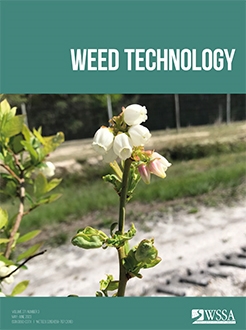Atrazine and S-metolachlor are the herbicides most relied on by growers to control weeds in sweet corn crops grown in the Everglades Agricultural Area (EAA) in southern Florida. Alternative weed management programs are needed. Field experiments were conducted in 2021 and 2022 to evaluate the efficacy of 1) pyroxasulfone (183 and 237 g ha–1) alone or as a premix with carfentrazone-ethyl (13 and 17 g ha–1) or fluthiacet-methyl (6 and 7 g ha–1), S-metolachlor (1,790 g ha–1) alone or in combination with atrazine (3,360 g ha–1) applied preemergence(PRE); 2) mesotrione (105 g ha–1), topramezone (25 g ha–1), and tembotrione (92 g ha–1) applied postemergence alone or in combination with atrazine (560 and 2,240 g ha–1) or bentazon (1,120 g ha–1); and 3) mechanical cultivation alone at the fourth and the fourth followed by the sixth leaf stages of sweet corn. PRE-applied herbicides did not provide acceptable control of fall panicum, common lambsquarters, or common purslane probably due to a lack of incorporation into the soil because of limited rainfall. POST-applied topramezone alone or in combination with atrazine or bentazon resulted in effective fall panicum control (>91%). Topramezone alone provided 83% and 88% control of common lambsquarters and common purslane, respectively, whereas atrazine added to topramezone resulted in >94% control of both weed species. Mesotrione and tembotrione plus atrazine provided excellent control (>93%) of both broadleaf weed species but poor fall panicum control (<72%). Mechanical cultivation alone did not effectively control any weeds. Overall, treatments that contained topramezone resulted in greater sweet corn yield. These results show that a combination of topramezone, mesotrione, and tembotrione with atrazine resulted in improved broadleaf weed control. Fall panicum control was improved only with the combination of topramezone with atrazine, showing that atrazine is an important mixture component of these herbicides to provide effective POST weed control in sweet corn on organic soils of the EAA.
Nomenclature: Atrazine; bentazon; mesotrione; pyroxasulfone; S-metolachlor; tembotrione; topramezone; common lambsquarters; Chenopodium album L. CHEAL; common purslane; Portulaca oleracea L. POROL; fall panicum; Panicum dichotomiflorum Michx. PANDI; sweet corn; Zea mays spp. saccharata






